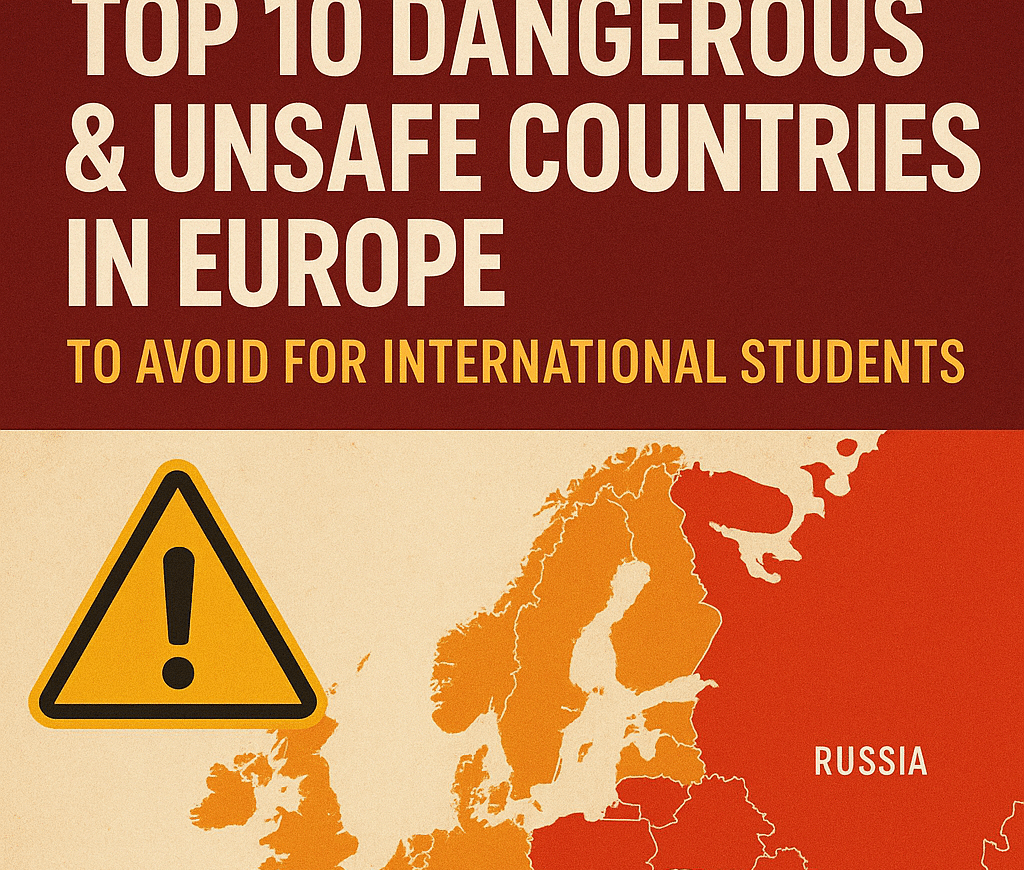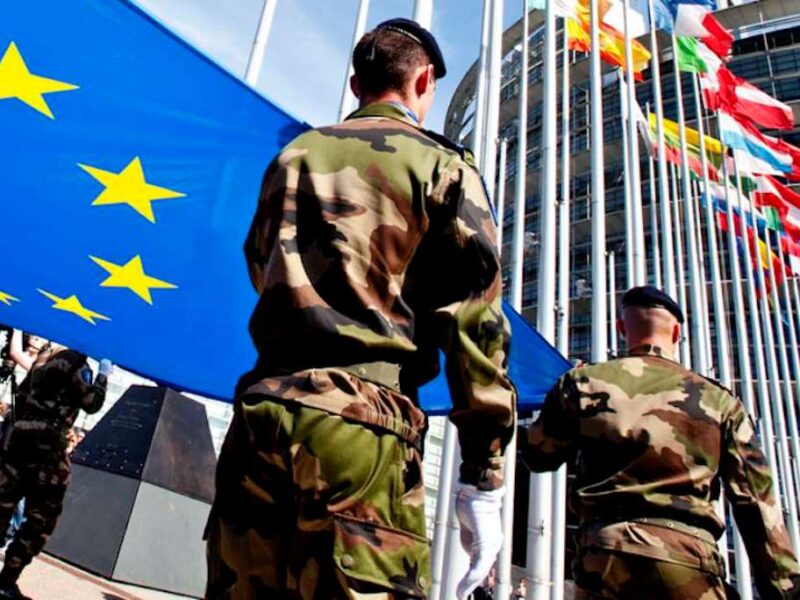Studying abroad is an exciting opportunity for international students to immerse themselves in new cultures, gain world-class education, and broaden their horizons. Europe, with its rich history and top-tier universities, is a prime destination. However, not all European countries are equally safe for international students. Safety concerns such as political instability, crime rates, and ongoing conflicts can make certain destinations risky. In this blog post, we’ll explore the top 10 dangerous and unsafe countries in Europe that international students should consider avoiding in 2025, based on recent data and global safety indices. Our goal is to provide clear, reliable information to help you make informed decisions about your study abroad plans.
Why Safety Matters for International Students
Choosing a safe study destination is crucial. International students often face unique challenges, such as navigating unfamiliar environments, language barriers, and cultural differences. A safe environment ensures you can focus on your studies and personal growth without worrying about personal security. Factors like violent crime rates, political unrest, and proximity to conflict zones can significantly impact your experience. To compile this list, we’ve analyzed data from authoritative sources like the Global Peace Index (GPI) 2024, travel advisories, and crime statistics to highlight countries where risks are notably higher for international students.
Top 10 Dangerous & Unsafe Countries in Europe for International Students
Below, we outline the 10 European countries that international students may want to avoid in 2025 due to safety concerns. Each entry includes key risks, supported by data, to help you understand why these destinations pose challenges.
1. Ukraine
Global Peace Index Score: 3.043 (2024)
Ukraine remains one of the most dangerous countries in Europe due to the ongoing war with Russia, which began in 2022. The conflict has led to widespread violence, missile strikes, and displacement, particularly in eastern and southern regions. Even in relatively safer western cities like Lviv, the risk of sudden escalations makes travel and residence hazardous. International students face significant challenges, including disrupted infrastructure, limited access to services, and constant security threats. Most Western governments, including the U.S. and UK, have issued “Do Not Travel” advisories for Ukraine.
Why Avoid? Active military conflict, unpredictable security situation, and disrupted educational infrastructure make Ukraine unsuitable for international students.
2. Russia
Global Peace Index Score: 3.142 (2024)
Russia’s ongoing involvement in the war with Ukraine, coupled with internal political repression and international isolation, creates a risky environment for international students. Arbitrary detentions, surveillance, and anti-foreigner sentiment have increased, particularly for students from Western countries. Cities like Moscow and St. Petersburg, while culturally rich, are subject to strict regulations and bureaucratic hurdles. The U.S. Department of State has issued a Level 4 “Do Not Travel” advisory due to these risks.
Why Avoid? Political instability, risk of detention, and heightened anti-foreigner sentiment pose significant threats to international students.
3. Belarus
Global Peace Index Score: 2.559 (2024)
Belarus, closely aligned with Russia in the Ukraine conflict, faces internal political crackdowns and proximity to active conflict zones. The government’s suppression of dissent, combined with military activity near its borders, makes it a high-risk destination. International students may encounter sudden border closures, surveillance, and limited access to consular support. The UK Foreign Office advises against all travel to Belarus due to these concerns.
Why Avoid? Political repression, proximity to conflict zones, and limited support for foreigners make Belarus unsafe for students.
4. Turkey
Global Peace Index Score: 2.840 (2024)
Turkey ranks as one of the least safe OECD countries in Europe, with high imprisonment rates and a GPI score indicating significant safety concerns. While popular tourist areas like Istanbul and Antalya are relatively safe, eastern border regions near Syria are volatile due to regional instability and occasional terrorist activity. Recent earthquakes in 2025 have also disrupted parts of the country, affecting infrastructure. International students may face challenges in less secure regions or during sporadic protests in urban centers.
Why Avoid? Regional instability, high crime rates in certain areas, and natural disaster risks make Turkey a cautious choice for students.
5. Serbia
Global Peace Index Score: 1.921 (2024)
Serbia is generally safer than the top three countries but faces risks from political tensions with Kosovo, which occasionally lead to protests and localized violence in border regions. Belgrade has experienced sporadic unrest, and the political climate can be unpredictable. While Serbia offers a rich cultural experience, international students should be cautious of areas near Kosovo and stay informed about local developments.
Why Avoid? Political tensions and occasional unrest pose risks, particularly in border areas and during protests.
6. Kosovo
Global Peace Index Score: Not individually ranked, but regional data applies
Kosovo, while culturally vibrant, experiences periodic ethnic clashes and political instability, especially in northern regions. These tensions can lead to localized violence, disrupting daily life and travel. International students may find it challenging to navigate the complex political landscape and limited infrastructure in some areas. Travel advisories from countries like Canada warn of risks in northern Kosovo.
Why Avoid? Ethnic tensions and political instability create an unpredictable environment for students.
7. Bosnia and Herzegovina
Global Peace Index Score: 1.893 (2024)
Bosnia and Herzegovina struggles with lingering ethnic divisions and political instability from its post-war recovery. Crime rates, including petty theft and organized crime, are higher than in Western Europe. International students may face challenges in less developed areas, where infrastructure and safety measures are limited. The U.S. Embassy advises caution in certain regions due to occasional unrest.
Why Avoid? Ethnic tensions, higher crime rates, and limited infrastructure pose challenges for students.
8. Moldova
Global Peace Index Score: 1.925 (2024)
Moldova’s Transnistria region is a significant safety concern, with a separatist government and Russian military presence creating a volatile environment. While Chisinau is relatively safe, the proximity to Ukraine’s conflict zones and political instability increase risks. The UK Foreign Office lists Transnistria as a “do not travel” zone, and students may face bureaucratic challenges elsewhere in the country.
Why Avoid? Regional instability in Transnistria and proximity to conflict zones make Moldova risky for students.
9. Albania
Global Peace Index Score: 1.833 (2024)
Albania has made strides in improving safety but still faces challenges with organized crime and corruption. Petty theft and scams targeting foreigners are common in tourist areas like Tirana. International students may also encounter inconsistent infrastructure and limited support services, making it less ideal for long-term study.
Why Avoid? Organized crime and petty theft pose risks, particularly for foreigners unfamiliar with the local environment.
10. North Macedonia
Global Peace Index Score: 1.854 (2024)
North Macedonia is relatively stable but faces occasional political protests and ethnic tensions. Crime rates, including theft and vandalism, are higher than in Western Europe, particularly in urban areas. International students should exercise caution, especially during political events, and ensure they have reliable support networks.
Why Avoid? Political protests and moderate crime rates create a less secure environment for students.
Summary Table of Unsafe Countries in Europe for International Students
| Country | Global Peace Index Score (2024) | Key Risks |
|---|---|---|
| Ukraine | 3.043 | Active war, missile strikes, infrastructure disruptions |
| Russia | 3.142 | Political repression, anti-foreigner sentiment, war involvement |
| Belarus | 2.559 | Political crackdowns, proximity to conflict zones |
| Turkey | 2.840 | Regional instability, high crime rates, natural disasters |
| Serbia | 1.921 | Political tensions with Kosovo, sporadic unrest |
| Kosovo | Not individually ranked | Ethnic clashes, political instability |
| Bosnia and Herzegovina | 1.893 | Ethnic divisions, higher crime rates |
| Moldova | 1.925 | Transnistria instability, proximity to conflict |
| Albania | 1.833 | Organized crime, petty theft |
| North Macedonia | 1.854 | Political protests, moderate crime rates |
How we ranked “dangerous” for students
- Official advisories: We cross-checked the U.S. State Department and UK FCDO country pages for 2025. Where either cites “Do Not Travel” or explicit regional exclusions, we flag it as high risk for study abroad planning.
- Conflict status & peace indices: Ongoing war or low peace scores (e.g., Ukraine, Russia, Türkiye) increase risk for foreign students. (See Global Peace Index 2024 for broader context.)
- On-the-ground constraints: Things like limited flights, embassy access, or regional landmines can directly affect students’ ability to arrive, study, and evacuate quickly.
Safer Alternatives for International Students in Europe
If you’re looking for safer study destinations in Europe, consider countries like Iceland (GPI: 1.107), Ireland (GPI: 1.312), Austria (GPI: 1.316), Denmark (GPI: 1.296), and Switzerland (GPI: 1.350). These nations consistently rank among the safest in the world, offering low crime rates, political stability, and excellent educational opportunities. For example, Ireland is renowned for its welcoming atmosphere and high-quality universities, while Austria’s neutrality and low crime make it ideal for students.
Tips for Staying Safe as an International Student in Europe
- Research Travel Advisories: Check government travel advisories (e.g., U.S. State Department, UK Foreign Office) before choosing a destination.
- Stay Informed: Monitor local news and political developments to avoid areas with protests or unrest.
- Secure Travel Insurance: Invest in comprehensive travel insurance to cover medical emergencies, trip cancellations, and lost belongings.
- Choose Reputable Institutions: Enroll in universities with strong support systems for international students, including safety resources.
- Avoid Risky Areas: Steer clear of border regions or areas known for instability, even in relatively safe countries.
Conclusion
While Europe is home to many safe and welcoming countries for international students, certain destinations pose significant risks due to conflict, political instability, or crime. You can study successfully in many parts of Europe—even in countries with complex security pictures—if you choose the right city, the right program, and the right support. However, the 10 countries/regions above demand an extra layer of due diligence. If you’re risk-averse or on a tight budget, shift your shortlist toward safer hubs and invest in comprehensive student health insurance, campus-vetted housing, and a clear evacuation plan.
Sources
[](https://www.study.eu/article/safest-countries-to-study-abroad-in-europe)
[](https://visitworld.today/blog/1561/the-most-dangerous-countries-in-europe-in-2025)
[](https://www.study.eu/article/safest-countries-to-study-abroad-in-europe)
[](https://visitworld.today/blog/1561/the-most-dangerous-countries-in-europe-in-2025)






